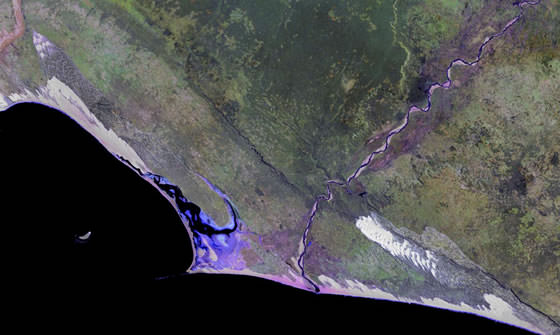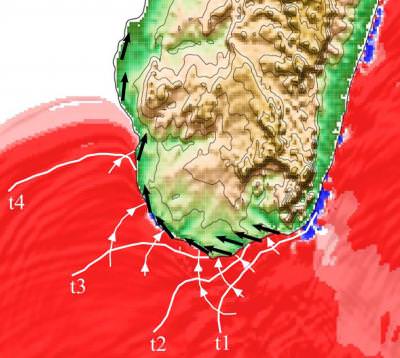[/caption]
Coastal formations called chevrons, large U- or V-shaped features found on coastlines around the world were originally thought to be evidence of ancient “megatsunamis” caused by asteroids or comets slamming into the ocean. However, new research using Google Earth and computer models to recreate large wave action refutes that school of thought.
The theory of chevrons being created by tsunamis was proposed in 2006 after the structures were found in Egypt and the Bahamas. Some were, at places, between several hundred meters- and a kilometer-wide. Since they were also found to exist in Australia and Madagascar, some geologists formed the hypothesis that they were sediment cones left behind by large tsunamis, perhaps up to ten times stronger than the devastating tsunami in the Indian Ocean in December 2005.
The theory propsed the only source for such a megatsunami was a meteor impact, occurring about 5,000 years ago.
But a new study, led by Jody Bourgeois, a geologist and tsunami expert at the University of Washington, argues that this theory is simply “nonsense. For example, she said, there are numerous chevrons on Madagascar, but many are parallel to the coastline. Models created by Bourgeois’ colleague Robert Weiss show that if they were created by tsunamis they should point in the direction the waves were travelling, mostly perpendicular to the shore.

“And if it really was from an impact, you should find evidence on the coast of Africa too, since it is so near,” she said.
By using Google Earth, Bourgeois and her team searched for chevrons and surprisingly they found some in desert areas, well inland and away from the shores.
“The extraordinary claim of ‘chevron’ genesis by megatsunamis cannot withstand simple but rigorous testing. There are the same forms in the Palouse in eastern Washington state, and those are clearly not from a tsunami,” Bourgeois said.
She believes the structures were formed by wind.
The discovery of marine fossils in some chevron formations seems to support the idea that a wave created the deposit, but Bourgeois discounts that evidence also.
“Marine fossils can get into non-marine deposits. It’s not uncommon. You only have to change sea level a little bit or have them wash up on a beach in a storm,” she said. “And some marine organisms can be carried by the wind. I am convinced these are largely wind-blown deposits.”
She noted that similar deposits have been seen on the Kamchatka Peninsula on Russia’s east coast, where she has conducted research for more than a decade.
“Those are made of volcanic ash, and they are not near the coast at all, yet they look very similar to these coastal chevrons,” Bourgeois said.
Source: Newswise


I am glad there are many who agree the Earth itself is capable of producing the most unusual landscapes, whether quickly like during the ice age, the collapse of the ice dams in Idaho causing the ‘Scablands’ of eastern Washington USA, the flow of the river was >10x that of the mouth of the Amazon River for a few days, or the filling of the bone-dry Mediterranean Sea that happens many times in the past. Many have heard of the giant eruptions of Tobu or Yellowstone, but the ‘very tiny’ ignimbrite eruption that caused the ‘valley of 10,000 smokes’ humans have not been witnessed by humans or were killed, leaving no history. A ignimbrite eruption is a super-duper pyroclastic flow of such density and heat and fluency the ash flow will fuse and in a +1000 cubic KM eruption, will cover river valleys hundreds of feet or meters deep and settle in a Level Plain perhaps +100miles or 160KM in all directions-level because it takes time to cool and harden. Less than 10% of ash goes into atmosphere. There are many other surprizes the Earth has for humans.!!!!